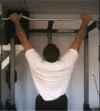Pull-up
The chin-up (from klimmen , a synonym for “to climb”) is a self-weight exercise in which the body is pulled up through the back in cooperation with the arms on a horizontal bar (chin-up bar) and then lowered again. The chin-up is an exercise that uses a large number of muscle groups at the same time, primarily the large back muscles . One speaks therefore of a compound exercise . In order to avoid overstressing the palms of the hands during repetition, one can rub the hands with chalk or magnesia or use sports gloves.
Muscles involved
- musculus latissimus dorsi (widest back muscle)
- teres major muscle (large round muscle)
- pectoralis major muscle (greater pectoral muscle)
- pectoralis minor muscle (small pectoral muscle)
- musculus biceps brachii (two-headed muscle of the arm)
- brachialis muscle (upper arm muscle)
- trapezius muscle (hood muscle)
- musculus triceps brachii (three-headed muscle of the arm)
- brachioradialis muscle (upper arm spoke muscle)
Training methods
Lat pulldown
The lat pulldown is a cable pull , on which you sit down and pull a bar down from above. This only partially simulates a pull-up, but offers beginners a good introduction, as your own body weight does not necessarily have to be pulled. When doing this, you have to breathe in and out regularly.
Complementary exercises
The pull-up is not a complete exercise for the back. Especially the lower part ( back extensor ) and the trapezius are not used enough or not at all. In order to avoid muscular imbalance, one should do a balanced back training and also train the rest of the body.
The pull-up is a strength exercise. It is not a remedy for existing back pain . Although it promotes an upright and physiological posture, in the case of pain caused by long periods of sitting or the like, condition-oriented and static exercises and the training of the stabilizing core muscles help (see back pain #Therapy and prevention ).
variants

|
Standard , in general |

|
The training intensity can be increased by using weights. |

|
One-handed execution. The exercise is very difficult. |
| Another modification is to use two handles running transversely to the body ( hammer grip ) instead of a rod running lengthwise to the body . This type of exercise is called a "tight pull-up" because the hammer-grip pull-ups are always made tight - wide pull-ups are hardly manageable with the hammer-grip. That is why most fitness studios have corresponding multi-component bars (different types of handles). | |
| If the legs are lifted forward at a 90 ° angle, the abdominal muscles are more stressed. A particularly intensive training effect is achieved by stretching the legs. However, this training variant is only recommended for advanced users. |
Chin-up bar
A pull-up bar is a piece of gymnastics equipment on which the body is pulled up and down again in cooperation with the arm and back muscles. In contrast to the horizontal bar , the chin-up bar is attached to a wall or ceiling. All pull-up bars have one horizontal tube in common, which can also consist of several individual pieces. The horizontal tube can be straight or curved.
The door bar is an alternative to wall mounting. This is a rod that is screwed, clamped or hung from above into a door frame. This variant of the pull-up bar is not preferred by bodybuilders because there is not much space to the left and right of the bar and the upper door frame is often too low. Head butts cannot therefore be ruled out. The legs also have to be bent due to the low height, which makes it much more difficult to support yourself with your feet in the event of a fall. Many types of construction offer sufficient strength of the rod and suspension for light people at best. Hollow designs in the form of a telescopic rod are particularly widespread, although they can be unstable.
literature
- Axel Gottlob: The chin-up - outdated relic or modern challenge . In: Fitness Tribune . No. 109 , p. 30–33 ( dr-gottlob-institut.de [PDF; 135 kB ]).
- RJ Sekerak, KP Zimmermann: Chin-up strength tests: does stature matter? In: Journal of Sports Medicine and Physical Fitness . tape 48 , no. 1 , 2008, p. 37-42 , PMID 18212708 .